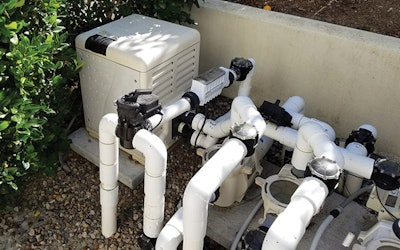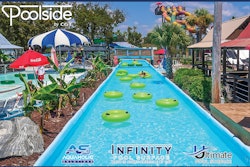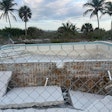
Before the introduction of chemical automation, a service technician would test the water in the pool and then add the appropriate dosages of chemicals. In the case of pools with attached spas, he or she would add the chemicals to the pool, thus subsequently treating the spa after the chemicals mixed in the pool. The tech would never test water in the pool and then add the chemicals to the spa. As far as I know, no one would ever see an advantage in adding chemicals to the smaller body of water first.
Since the introduction of chemical automation, however, that is in effect what happens much of the time. It all has to do with the way the spa bypass and chemical injection points are plumbed. In many cases, the system is essentially first dosed (or overdosed) in the spa before entering the pool.
For treatment methods such as adding sodium hypochlorite or using tablet feeders, adding chemicals to the spa first is not a major issue, although still arguably far from ideal. When that happens with saltwater chlorine generators, however, it becomes a far more significant problem. Here's why.
BASIC CHARACTER
In markets where there are both large numbers of attached pool/ spa combos and widespread use of SCGs, such as the greater San Diego area where I've spent most of my career, this issue becomes surprisingly common. That's largely because people simply don't stop and think about what they're doing.
Let me reiterate: with other treatment methods it's not a big issue, but with the characteristics inherent in SCGs, it's a problem. Consider these facts about SCG technology:
- SCGs use a process known as electrolysis to produce chlorine gas, which immediately dissolves into hypochlorite and hypochlorous acid. Hypochlorous acid is the active form of chlorine in your pool water whether it's delivered in a tablet, liquid or gas form. When dissolved in water, you get hypochlorous acid.
- SCGs also produce sodium hydroxide, a pH increaser. Sodium hydroxide is a byproduct of saltwater chlorine generation because the sodium in the salt combines with hydrogen and oxygen in the water to form sodium hydroxide. As a strong base, it neutralizes acid, thus raising pH.
With pH increasing in the spa as a result of the SCG outputting directly to that small body of water, you wind up with inordinately high pH levels (along with inherent high temperatures). This creates a set of possible problems in the spa stemming from poor water balance.
First, there are the issues associated with precipitating calcium compounds, including the formation of scale on any surface directly in contact with high pH water for extended periods of time. There will also likely be calcium precipitation from high temperatures produced by either the SCG or the heater. In addition, chunks of calcium carbonate are released from some SCGs during the self-cleaning function.
RELATED: The Persistent Myths of Salt Systems
 Here the SCG is installed on the pool return. This system uses the return valve as the spa bypass.
Here the SCG is installed on the pool return. This system uses the return valve as the spa bypass.
These are issues for the entire circulation system, but when all of those precipitates are deposited in the spa, the impact is dramatically increased in the form of poor water quality and damage to surface materials and ultimately bather discomfort, as well as compromised aesthetics.
As problematic as that all sounds, the simple fact that high pH will cause significant irritation for some bathers may be the most significant. After all, people use their spas for comfort and relaxation, and experiencing skin and eye irritation runs counter to the point of owning a spa in the first place.
Another big issue is disproportional chlorination. This occurs when two vessels, one smaller than the other, are being chlorinated by a single source and the return volume to each body of water is not properly regulated based on their specific volumes. For example, a 1,000 gallon spa is 1/15 the volume of a 15,000-gallon pool. This tells us that no greater than 1/15 of the chemically treated return water should at any time be returned to the spa during regular filtration cycles. More than that, and you have higher levels of chlorination in the spa.
I won't go into the list of potential problems associated with elevated chlorine residuals. Of course, the irony is that many consumers turn to saltwater chlorination, believing that it somehow reduces chlorine levels, which in an optimum scenario may be true to some extent. But in this very common set of circumstances, when they're using their spa, chlorine concentrations can be considerably higher than recommended.
One of the factors exacerbating the problem is that many spas these days are "high demand," meaning they require a large amount of water flowing into to them to make perimeter overflows or vanishing edges function properly. In many plumbing schemes, most or all of that required flow comes directly from the SCG. Regardless, the problem and fix all comes down to plumbing and the proper use of chemical automation.
 Older bypasses often use a diverter pipe, a check valve and a two-port valve from the pool return line to the spa return line, plumbed after the three-port valve to return water to the spa.
Older bypasses often use a diverter pipe, a check valve and a two-port valve from the pool return line to the spa return line, plumbed after the three-port valve to return water to the spa.
BYPASS MORASS
Before I offer my solution, let's look at a couple of common ways spa bypasses have been plumbed.
Older bypasses often use a diverter pipe, a check valve and a two-port valve from the pool return line to the spa return line, plumbed after the three-port valve to return water to the spa. As manufacturer specifications state, the SCG should be placed ahead of the three-port return valve. The design (size of pipe) of the spa bypass would depend on the desired flow required for the spa spillway to function as intended. The trouble is that any flow greater than the division of the pool volume by the spa volume would most likely result in disproportionate chlorination (and the problems that follow).
RELATED: How Salt Chlorine Generators Work
There's an updated version of the bypass that is far more common now, which I believe is largely due to the introduction of the valve actuator. In this configuration, the spa bypass occurs right at the three-port valve, eliminating the bypass described above. A check valve is placed on the spa return to eliminate spa drain-down when the circulation pump shuts off. By using this design, the higher flow rates through the spa bypass can be better controlled. Still, this design will usually always result in disproportionate chlorination.
Neither of these two bypasses properly address the concerns listed above, even when a SCG has been installed per manufacturer specification. Calcium precipitation and scale will find their way into the spa. For this reason, it is becoming popular to place the SCG on the pool return line after the three-port return valve.
This makes sense to those who have no concern for having the ability to chlorinate the spa while in spa mode. There will never be calcium chunks in the spa, the spa water will be in balance with the pool water, and the pool cleaner will pick up the calcium chunks. Oftentimes, when I've asked pool professionals about not being able to sanitize the spa while in spa mode, most don't see it as an issue. They're not concerned with it, or they say there should be plenty of chlorine in the spa.
Earlier this year I was called out to a prospective client's house to give a quote for pool service. As I approached the pool equipment I saw that the SCG had been placed on the pool return line. I told the prospective client what that means for the spa — per the design of the builder there would be no available chlorination while in spa mode.
So how do you treat the spa without over treating it?
THE FIX
Back in late 2008, my company was experiencing the same issues with SCGs everyone else seemed to be having. In response to the problem, we developed for our own purpose what we call a "pre-chem spa bypass," which we believe is, in fact, the answer to SCG use in pools with attached spas. The proper placement of the pre-chem spa bypass is after the heater and before the SCG, just ahead of all chemical (SCG or acid injection) automation.
Now, only previously treated pool water is ever returned to the spa during the regular filtration cycle and because the SCG is treating only the pool, all calcium carbonate chunks return to the pool during the regular pool/spa filtration cycle. When spa mode is selected, the spa is then able to be treated at what amounts to a proportional rate.
RELATED: With a Grain of Salt
Also, these days (and depending on which SCG manufacturer you use), you can set the self-cleaning cycle for up to a five-hour interval to help prevent cell reversal during the time the spa may be in use.
This solves all but one issue, elevated pH. Scale issues in spas are usually the direct result of disproportional chlorination causing very high pH. This is why I firmly believe you should never install a SCG without the aid of an acid injection system to lower pH.
Knowing what we know now, an SCG without an acid injection system is simply irresponsible, in my opinion. How can we not make it a standard to require chemical control automation when choosing to install a SCG?
If SCGs are plumbed correctly and used in conjunction with pH control, they can be used far more effectively than they have in the past.











































